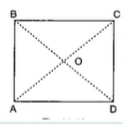If the diagonals of a quadrilateral are equal and bisect each other at right angles, then the quadrilateral is a
reactangle
square
rhombus
trapezium
The correct Answer is:B
To determine the type of quadrilateral where the diagonals are equal and bisect each other at right angles, we can analyze the properties of different quadrilaterals.
1. Understanding the Properties of Quadrilaterals:
- A quadrilateral is a four-sided polygon. The properties of its diagonals can help us identify its type.
2. Given Conditions:
- The diagonals of the quadrilateral are equal.
- The diagonals bisect each other at right angles (90 degrees).
3. Analyzing Each Option:
- Rectangle:
- In a rectangle, the diagonals are equal, but they do not bisect each other at right angles. Thus, a rectangle cannot be the answer.
- Rhombus:
- In a rhombus, the diagonals bisect each other at right angles, but they are not equal. Hence, a rhombus cannot be the answer.
- Trapezium:
- In a trapezium, the diagonals are not necessarily equal unless it is an isosceles trapezium, and even then, they do not bisect each other at right angles. Therefore, a trapezium cannot be the answer.
- Square:
- In a square, the diagonals are equal and they bisect each other at right angles. This satisfies both conditions given in the question.
4. Conclusion:
- Since the only quadrilateral that meets both conditions (equal diagonals and diagonals bisecting at right angles) is a square, we conclude that the quadrilateral is a square.
Final Answer:
The quadrilateral is a square.
---
- A quadrilateral is a four-sided polygon. The properties of its diagonals can help us identify its type.
- The diagonals of the quadrilateral are equal.
- The diagonals bisect each other at right angles (90 degrees).
- Rectangle:
- In a rectangle, the diagonals are equal, but they do not bisect each other at right angles. Thus, a rectangle cannot be the answer.
- Rhombus:
- In a rhombus, the diagonals bisect each other at right angles, but they are not equal. Hence, a rhombus cannot be the answer.
- Trapezium:
- In a trapezium, the diagonals are not necessarily equal unless it is an isosceles trapezium, and even then, they do not bisect each other at right angles. Therefore, a trapezium cannot be the answer.
- Square:
- In a square, the diagonals are equal and they bisect each other at right angles. This satisfies both conditions given in the question.
- Since the only quadrilateral that meets both conditions (equal diagonals and diagonals bisecting at right angles) is a square, we conclude that the quadrilateral is a square.
The quadrilateral is a square.
Topper's Solved these Questions
- BOOK - ARIHANT SSCCHAPTER - GEOMETRYEXERCISE - INTRODUCTORY EXERCISE - 12.145videos
GEOMETRY
- BOOK - ARIHANT SSCCHAPTER - GEOMETRYEXERCISE - INTRODUCTORY EXERCISE - 12.2100videos
GEOMETRY
- BOOK - ARIHANT SSCCHAPTER - GEOMETRYEXERCISE - EXERCISE(LEVEL 2)52videos
GEOMETRY
- BOOK - ARIHANT SSCCHAPTER - FUNDAMENTALS EXERCISE - TEST OF YOU - LEARNING - 240videos
FUNDAMENTALS
- BOOK - ARIHANT SSCCHAPTER - HCF AND LCMEXERCISE - Exercise Higher Skill Level Questions18videos
HCF AND LCM
Similar Questions
Knowledge Check
- Question 1 - Select One
If the diagonals of a quadrilateral bisect each other at right angles, then this quadrilateral is
Aa rectangleBa rhombusCa kiteDnone of these
In figure, Show that if the diagonals of a quadrilateral are equal and bisect each other at right angle, then it is a square.
 View Solution
View SolutionIf the diagonals of a quadrilateral bisect each other at right angle, then the quadrilateral is a parallelogram (b) rectangle (c) rhombus (d) kite
View SolutionShow that the diagonals of a square are equal and bisect each other at right angles.
View SolutionShow that the diagonals of a square are equal and bisect each other at right angles.
View SolutionIf the diagonals of a quadrilateral bisect each other at right angles, then this quadrilateral is a
View SolutionIf the diagonals of a quadrilateral bisect each other at right angle, prove that the quadrilateral is a rhombus.
View SolutionThe diagonals of a rectangle are equal and bisect each other
View Solution

